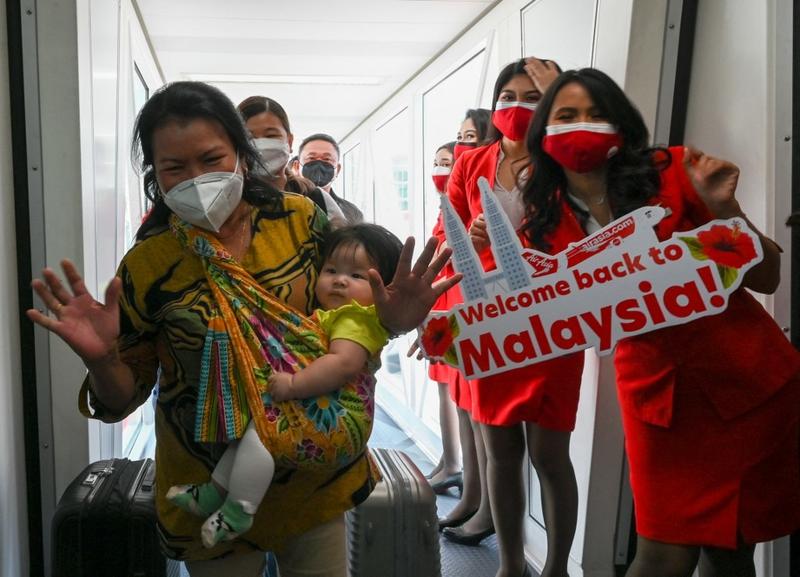 A woman carries an infant upon arrival from Jakarta after landing at Kuala Lumpur International Airport 2 (KLIA 2), as Malaysia reopened its borders for travelers fully vaccinated against the coronavirus, in Sepang on April 1, 2022. (MOHD RASFAN / AFP)
A woman carries an infant upon arrival from Jakarta after landing at Kuala Lumpur International Airport 2 (KLIA 2), as Malaysia reopened its borders for travelers fully vaccinated against the coronavirus, in Sepang on April 1, 2022. (MOHD RASFAN / AFP)
HANOI / BANDAR SERI BEGAWAN / YANGON / SINGAPORE / SEOUL / WELLINGTON / KUALA LUMPUR / ULAN BATOR / ISLAMABAD / SUVA / NEW DELHI / CANBERRA - Malaysia opened its borders to international travel on Friday, ending restrictions that have been in place since the COVID-19 pandemic began in 2020.
Among measures adopted by Malaysian authorities to facilitate the travel of non-Malaysian nationals to the country are the abolishing quarantine requirements for vaccinated travelers, with only a pre-departure test and a test within 24-hours of arriving in Malaysia.
Tourism, Arts and Culture Minister Nancy Shukri said over 10,000 foreign travelers and Malaysians residing abroad are expected to arrive at airports nationwide on Friday alone and the ministry is targeting over 2 million tourist arrivals within the year.
"After two years, today is a historic moment and a huge relief for our tourism industry as we welcome international tourists, newcomers and regulars alike, back to Malaysia, supporting our economy again," she told reporters at an event to mark the reopening at the Kuala Lumpur International Airport (KLIA).
Separately, Transport Minister Wee Ka Siong noted the influx of travelers moving across the bridge connecting Malaysia and Singapore, allowing families to reunite ahead of Ramadan, the Islamic fasting month, and Qingming, a traditional tomb-sweeping festival.
The relaxed standard operating procedures (SOP) and other measures, while welcome, must not mean that caution is thrown to the wind, according to Malaysian Medical Association (MMA) President Koh Kar Chai.
Malaysia reported 18,560 new COVID-19 infections as of midnight Thursday, bringing the national total to 4,201,919, according to the health ministry. A further 44 deaths have been reported, bringing the country's COVID-19 death toll to 34,983.
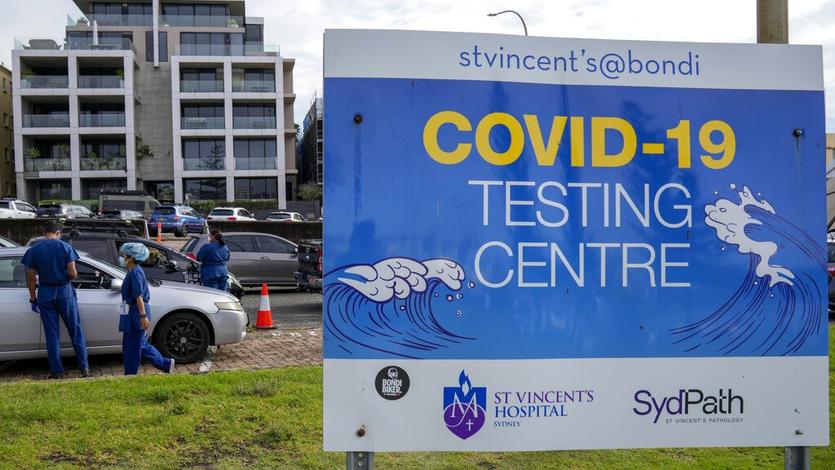 Staff check a client at a drive-through COVID-19 testing clinic at Bondi Beach in Sydney, Australia on Jan 8, 2022. (MARK BAKER / AP)
Staff check a client at a drive-through COVID-19 testing clinic at Bondi Beach in Sydney, Australia on Jan 8, 2022. (MARK BAKER / AP)
Australia
Australia's peak public health body has warned that the nation's spike in coronavirus cases will likely peak in mid-April.
The Australian Health Protection Principal Committee (AHPPC) on Thursday night published an update on Australia's preparedness for an expected surge in COVID-19 cases in winter.
It revealed that the number of new cases reported every day in Australia increased by more than 76 percent between March 11 and March 23 while hospitalizations rose by nearly 25 percent.
It attributed the increase to the emergence of the more transmissible Omicron BA.2 sub-variant and waning protection from vaccines and previous infections.
"These trends are aligned with the experience reported internationally. We also note forecasting which suggests this current wave will peak around mid-April in many jurisdictions," it said in a statement.
Australia on Friday reported more than 60,000 new coronavirus cases and 16 deaths, taking the pandemic death toll past 6,000.
The AHPPC also on Thursday flagged removing quarantine requirements for all close contacts of COVID-19 cases, instead recommending mitigation measures such as frequent rapid testing, mask wearing and avoiding high-risk settings.
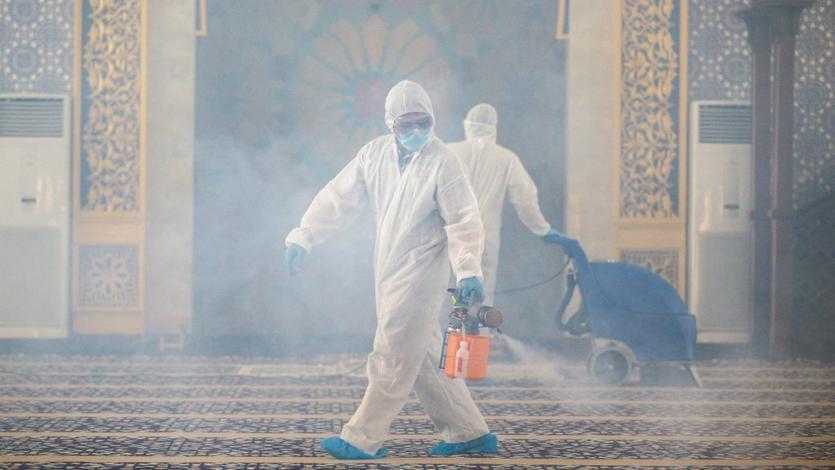 Workers wearing protective suits spray disinfectant at Suri Seri Begawan Raja Pengiran Anak Damit Mosque in an effort to counter the spread of the COVID-19 in Bandar Seri Begawan in Brunei on March 17, 2020. (PHOTO / AFP)
Workers wearing protective suits spray disinfectant at Suri Seri Begawan Raja Pengiran Anak Damit Mosque in an effort to counter the spread of the COVID-19 in Bandar Seri Begawan in Brunei on March 17, 2020. (PHOTO / AFP)
Brunei
Brunei reported 686 new COVID-19 cases on Thursday, bringing the national tally to 134,412.
As a country of 420,000 people, Brunei has recorded less than 1,000 new cases for eight straight days after the daily increase during the Third Wave of the pandemic reached its peak on March 3, 2022 with 4,885 cases.
As of March 30, 61.3 percent of Brunei's population have received three doses of COVID-19 vaccines.
India
As the COVID-19 cases are significantly showing a declining trend over the past few weeks, several Indian states have decided to lift all the pandemic-related restrictions, including the mandatory wearing of face masks from Friday.
While Maharashtra decided to lift all COVID-19 restrictions, Delhi said that there will be no fine for not wearing face masks in public places. The West Bengal government also announced that all COVID-19 induced restrictions in the state would be withdrawn on Friday.
The local government in Maharashtra also issued an order that would end all stringent restrictions almost after two years in the state on Friday.
The state government, however, has recommended physical distancing and voluntary wearing of face masks as a precaution, though there will be no penalties for defaulters.
Likewise, with the COVID-19 situation having considerably improved in West Bengal, the local government announced that all curbs related to the contagion would be removed on Friday.
India's federal health ministry Friday morning said the country recorded 1,335 new COVID-19 cases and 52 deaths during the past 24 hours.
Mongolia
Mongolia's COVID-19 tally rose to 469,521 on Friday after 127 new COVID-19 infections were reported in the past day, according to the country's health ministry.
No new related deaths were reported, leaving the national death toll unchanged at 2,108.
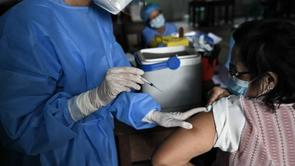 A health worker gives the first-time dose of COVID-19 vaccine to a woman, part of the 65 years and older tier, in a school being used as a vaccination site in Yangon, Myanmar on Feb 5, 2021. (STR / AFP)
A health worker gives the first-time dose of COVID-19 vaccine to a woman, part of the 65 years and older tier, in a school being used as a vaccination site in Yangon, Myanmar on Feb 5, 2021. (STR / AFP)
Myanmar
Myanmar's Central Committee on Prevention, Control and Treatment on Thursday issued an order to extend the period for preventive measures against the pandemic until the end of April.
The extension will be applied to all orders, announcements and directives previously issued by the respective union level government organizations and ministries, the announcement said.
According to the Ministry of Health, Myanmar reported 139 new COVID-19 cases with a daily positivity rate of 1.07 percent on Thursday.
The number of COVID-19 infections has reached 611,587 in the country, the ministry said.
The country's death toll remains at 19,430 as no new deaths from COVID-19 have been reported for four consecutive days, official data showed.
New Zealand
New Zealand reported 13,475 new community cases of COVID-19 on Friday, the Ministry of Health said in a statement.
The ministry also reported 17 new deaths from COVID-19 in the country.
Among the new community infections, 2,392 were recorded in the largest city Auckland. The rest of the cases were identified across the nation, including 2,122 in Canterbury, according to the ministry.
Pakistan
Pakistan reported 180 new COVID-19 cases and four more deaths over the past 24 hours, the country's health ministry said on Friday.
According to the data released by the ministry, the country's overall tally of COVID-19 cases has risen to 1,524,973.
Samoa
Samoa has confirmed its first COVID-19 related death as the number of COVID-19 cases is now surging in the island nation.
According to Samoa's newspaper Samoa Observer on Friday, Samoa's Ministry of Health has confirmed that a 67-year-old male, who was a positive case, died on Wednesday with a pre-existing medical condition.
The ministry also confirmed that Samoa has reported 170 new positive cases, bringing the total number of COVID-19 cases in the island nation to 1,831, with 1,408 active community cases.
 Digital screens showing safety precautions against the coronavirus are seen in a subway train in in Seoul, South Korea on March 22, 2022. (AHN YOUNG-JOON / AP)
Digital screens showing safety precautions against the coronavirus are seen in a subway train in in Seoul, South Korea on March 22, 2022. (AHN YOUNG-JOON / AP)
South Korea
South Korea said on Friday it would further relax its social distancing rules next week and possibly scrap most pandemic-related curbs later this month, including an obligation to wear masks outdoors.
From April 4, a curfew on eateries and other businesses will be pushed back to midnight from 11 pm, and private gatherings of up to 10 people will be allowed, Health Minister Kwon Deok-cheol said.
The government will look into removing restrictions, except for wearing masks indoors, if the daily caseload continues to fall and the medical system for severe patients is stably managed over the next two weeks, Kwon said.
The Korea Disease Control and Prevention Agency (KDCA) reported 280,273 infections for Thursday, bringing the total tally to 13,375,818, with 16,590 deaths.
Kwon said the wave had topped out since its mid-March peak when the daily count of cases had surpassed 620,000, though it is possible critical cases and deaths could rise further.
A recent surge in severe cases and deaths has saturated crematories and funeral homes nationwide.
To lessen the strain, the government will ease funeral regulations and lift a ban on burying COVID-19 victims, Kwon said.
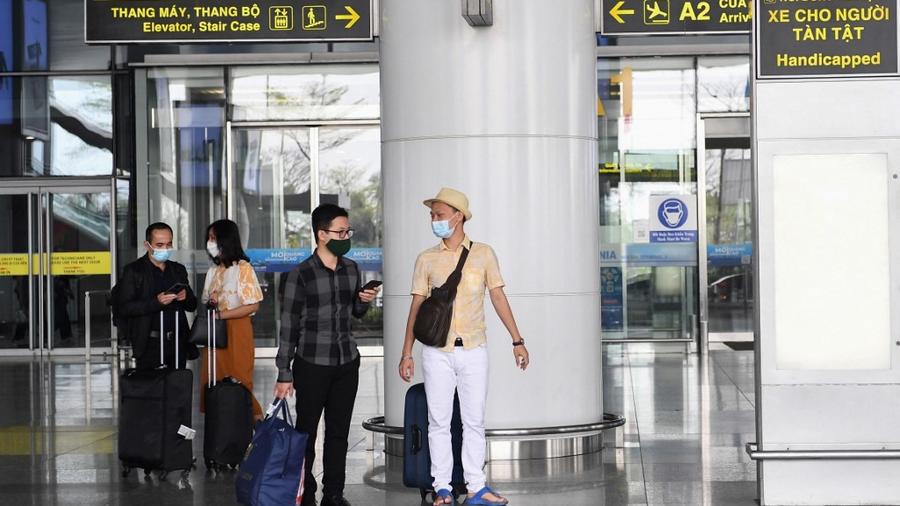 Passengers wait for transportation outside the arrival hall of Noi Bai International Airport in Hanoi on March 15, 2022, as Vietnam announced the return of a visa exemption policy for 13 countries in an effort to kickstart its tourism sector. (NHAC NGUYEN / AFP)
Passengers wait for transportation outside the arrival hall of Noi Bai International Airport in Hanoi on March 15, 2022, as Vietnam announced the return of a visa exemption policy for 13 countries in an effort to kickstart its tourism sector. (NHAC NGUYEN / AFP)
Vietnam
With proactive and continuous efforts, Vietnam is stepping up the resumption of international tourism while flexibly adapting to the COVID-19 pandemic.
Taking place here from Thursday to Sunday after two years of suspension, the Vietnam International Travel Mart 2022, the largest annual tourism trade fair in the Southeast Asian country, marked the reopening of the Vietnamese tourism sector in the new normal context.
On another positive note, the country welcomed roughly 91,000 international arrivals in the first quarter of this year, surging 89.1 percent against the same period last year, said its General Statistics Office.
Several new products like marine tourism, cultural tourism and eco-tourism with unique features of localities have been launched as highlights for the upcoming summer travel season.
On March 15, the country fully reopened its borders to foreign visitors after nearly two years of COVID-19 disruption. Accordingly, most traveling restrictions had been removed for international arrivals to Vietnam.
Visitors now only need to prove that they have been fully vaccinated or recovered from COVID-19, with a negative test result as per requirements by local health authorities. They are also required to have insurance coverage of at least $10,000 for possible COVID-19 treatment in Vietnam.
Vietnam had resumed the visa exemption policy for citizens from 13 countries including Japan, South Korea, and Russia, its key tourism markets, on the same day. Prior to this, all restrictions on the frequency of international flights were officially removed since Feb 15.
The country hosted a record number of more than 18 million visitors in 2019, the last full year before the coronavirus outbreak, compared to just 157,000 foreign arrivals in 2021 due to border closures. It has set a target of receiving over 5 million foreign tourists in 2022, according to the Vietnam National Administration of Tourism (VNAT).
"Opening at this time is to resume the market so that we can welcome international visitors between this September and March 2023, our annual peak season," VNAT general director Nguyen Trung Khanh told local media.


